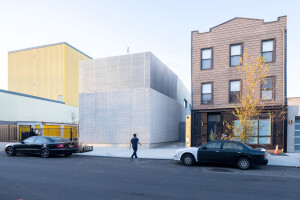Skidmore, Owings & Merrill (SOM) has designed a curvilinear installation constructed of brown-colored, algae-based masonry blocks for the 2023 Chicago Architecture Biennial. Developed in partnership with the US company Prometheus Materials, the featured Bio-Block product offers a carbon-neutral alternative to standard CMU blocks.
The installation is constructed on the ground floor of an office building in Chicago’s Fulton Market District. It makes use of 544 Bio-Blocks arranged in a 2.2 meter (7 foot 4 inch) tall construction to demonstrate a savings of more than one metric ton of carbon when compared to typical CMU construction. SOM designed the installation as an extruded spiral which resembles a snail shell and other whorled patterns found in nature. The curved wall features rotated blocks which permit apertures for views from within the installation to the street. Pleated ends improve the structural stiffness of the wall and allow it to be self-supported. The installation was constructed by union masons using conventional masonry techniques.
Prometheus Materials is a start-up company spun out of a research program at the University of Colorado Boulder. An enterprise founded by scientists and engineers, it collaborates with SOM to explore applications for biological materials. Its aim is to turn the construction industry into a positive force in the fight against climate change. And bio-cement is a necessary place to start: according to the think tank Chatham House, more than 4 billion tons of cement are produced each year, which accounts for roughly eight percent of global CO2 emissions. Even small innovations related to concrete production have the potential to significantly reduce these emissions at scale.
According to Prometheus Materials and SOM the Bio-Blocks are fabricated out of naturally carbon-sequestering microalgae combined with water, sunlight and CO2 to create a material which is chemically similar to the calcium carbonate found in coral reefs and oyster shells. This bio-cement can be mixed with aggregate to create a net-zero-carbon building material with mechanical, physical and thermal performance properties comparable to Portland cement-based concrete. Prometheus Materials currently grows algae and manufactures the blocks in its factory before shipping to customers, though it aims to reduce transportation greenhouse gas emissions by eventually providing only the biogenic components of the mix along with a proven mix design, to allow the product to be fabricated using local resources close to its end-use site.
Bio-concrete can be produced according to a variety of colors, textures and molded shapes. As the development of this biogenic living building material has progressed, its producers have achieved compressive strengths similar to that of traditional concrete. According to the manufacturer, the material also appears to have improved tensile properties and fracture resistance. Bio-Block is in the midst of ongoing performance testing and its production process is patent-pending.









































